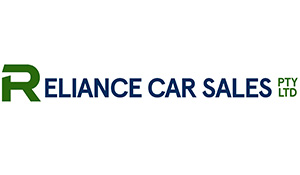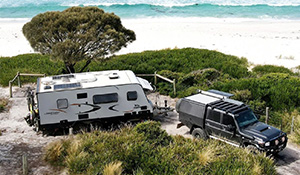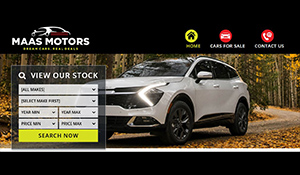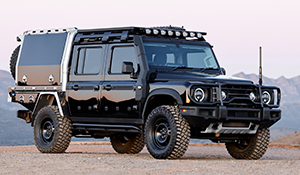Feature Vehicle Toyota LandCruiser79 Double Cab
Words Dean Mellor Photos Supplied



The Toyota LandCruiser 79 Double Cab you see on these pages was one of the first of its kind to land in Australia and, despite only showing a modest 118,000km on the odo, it’s one seriously well-travelled 4x4 beast.
“We did three months in the Kimberley, so all the off-road stuff there, the Carson River Track, it’s done eight or nine Simpson crossings, the Hay River Track, up and down the east coast, down to Tassie… basically the only place it hasn’t gone is Geraldton to Broome,” says Adam Craze, the Cruiser’s pilot and Director 4x4 Products at Ironman 4x4. “We have the Canning Stock Route planned for this year, just to fill in a bit more of that gap, and we’ve also done the Gibson Desert, the Simpson Desert… pretty much everywhere.”
The LandCruiser, which was bought new in 2013, was originally built for display at the Speciality Equipment Manufacturer’s Association Show in Las Vegas in the USA, better known as the SEMA Show. “It was one of the first ones in Victoria,” says Adam.
Ironman 4x4 really wanted the Cruiser to have a big impact on their stand at the SEMA Show, which is no easy task when monster trucks with mile-high lifts are the norm, so the focus was to present it as a vehicle that’s set-up for four-wheel drive touring rather than rock crawling.
“We built a stand and we thought we’d take something that would stand out,” explains Adam. “If we took a Jeep or something like that, we thought we’d be second fiddle to whatever had been done in America. They don’t have access to the 70 Series in the US, so we thought ‘let’s take a 70 that will have an impact for the first year’, so we decked it all out in all the camping gear. At the time, overlanding was just [kicking off] over there – it’s not really a big thing like it is here – so we set it up with the rooftop tent and the fridges and storage boxes, and set the tent up, and it drew heaps of attention.
“We got interviewed by NBC and had lots of people climbing into the tent – rooftop tents were few and far between over there at the time – and it drew massive crowds and we had plenty of people wanting to buy it there and then,
“Luckily, we had the opportunity to keep it over there for a month after SEMA, and we got to drive it around…”



The build
One of the main modifications to the LC79 was the fitment of a Mark’s 4WD portal-axle kit. This set-up offers several benefits, not least of which is added ground clearance allowing the legal fitment of 35-inch tyres. Of equal importance, however, are the numerous other benefits, including a widened track front and rear, addition of air-operated free-wheeling hubs and inclusion of a ‘proper’ transmission-mounted park brake replacing the ineffective OE set-up.
“With the portals, they laminate the diffs, and the back one is a full-custom rear diff, which is wider to suit the front track – the back track increases about 200mm and the front is about 100mm wider – it’s got air-operated free-wheeling hubs, so there’s a button on the dash to lock the hubs in, and it includes the handbrake upgrade as well, which works heaps better,” says Adam.
Other than the fitment of an Ironman 4x4 snorkel, exhaust system and a remap of the ECU, the Cruiser’s engine remains largely unchanged. “It’s the pre DPF model so it’s got an Ironman three-inch turbo-back exhaust, the ECU has been remapped and there’s an iDrive as well,” says Adam.
The iDrive is a throttle controller with different user-selectable settings that allow throttle response to be tailored to suit different driving situations. “It helps when you’re accelerating but I also use it quite a lot off-road, because it’s got an ‘Eco’ mode,” explains Adam. “If you’re doing big rock bouncing, and your foot’s bouncing up and down on the accelerator, it slows down the reaction and stops the wheelspin, so it’s actually really handy when you want to go slow.”



Another big out-of-sight improvement is the fitment of a later-model gearbox, which makes touring long distances far more pleasant. “I put the later-model LandCruiser gearbox in it, the 2017 gearbox, which has taller second and fifth gears,” says Adam, who reckons this is one of the best modifications anyone can make to an earlier model TDV8 70 Series. “It’s quite a cheap modification too; I think the gearbox cost around $2800, and that came with the fork and all the sensors in it, so all we had to do was put oil in it and bolt it up – brand new from Toyota!”
As you’d expect, the Cruiser runs Ironman 4x4 suspension and features a 3900kg GVM upgrade. “We’ve got the Foam Cell Pro suspension kit in there,” says Adam. “It’s a two-inch lift above standard with some load-carrying rear leaf springs, and we’re running the Foam Cell Pro shocks, which is a bigger bore shock that was developed for the military and armoured vehicles, and we’ve converted over into the consumer side of things. They’ve got a 3mm body, so they’ll stand up to any punishment… it’s also got greaseable shackles and urethane bushes.”
Aiding traction in slippery and undulating conditions are the standard fitment Toyota electronic front and rear diff locks, but if they aren’t enough to get the job done there are Ironman 4x4 rated recovery points up front and a Mark’s 4WD high-clearance towbar at the rear that comes with a pair of integrated recovery points.
Protection equipment [mostly] comes straigh out the Ironman 4x4 catalogue. “It’s got the Ironman Premium Deluxe big tube bar, with big tube side rails and steps to match, but I made the alloy underbody skid plate for the front of it, which runs from the bull bar down towards where the drag-link arms are,” says Adam. “It protects the radiator and the air conditioning condenser and steering components.”
The bar is home to an Ironman 4x4 12,000lb Monster winch and a pair of Ironman 7-inch round LED driving lights. Aiding illumination is a 135W curved lightbar on the bull bar’s top tube.



The Inside Story
When the vehicle was first shipped to SEMA it was fitted with a custom tray with a couple of drawers at the rear and a frame to hold an Ironman rooftop tent and awnings. The tray also held items including two Ironman 50L fridges, recovery tracks and other equipment.
This configuration remained in place when Adam was back in Australia and he took the Cruiser touring through WA. “Originally, we had the back set up with a tray and a roof-top tent, and we did three months in the Kimberley like that, and I just came back thinking it would be nice to have a canopy so everything’s not out in the dust.” So that was then next modification.
“It’s a Bull Motor Bodies canopy; it’s an aluminium and ABS plastic canopy. I did three months in the Kimberley touring around and it’s probably the best one I saw up there without dust or anything in it at the time, which was around 2014.”
Two spare wheels hang off the back of the canopy, which features a strong internal alloy frame.
Inside the canopy resides an Ironman double-stacked drawer system, with cages hanging from the ceiling to hold camp chairs and the like. There’s also a separate power set-up for the canopy, consisting a couple of Fullriver HC batteries – which are advanced AGM dual-purpose batteries with cranking power and deep-cycle capabilities – and these are kept topped up by an Ironman 40 Amp DC to DC charger and a roof-mounted 200W solar panel. “This is enough to keep the two fridges running full time, so I never have to turn the fridges off,” says Adam.
Up front, the standard Toyota seats have been flicked in favour of a pair of comfortable Recaro heated seats, which Adam says are great for touring in the High Country in winter. And the OE head unit has been replaced with a double-DIN Zenec unit that incorporates a reversing camera and runs Hema mapping software. There’s also a dash-mounted Hema HX-1 Navigator.
The rear seats have also been flicked, and in their place are the two 50L Ironman fridges that used to sit in the tray. These are mounted to Ironman fridge slides, but in a fore/aft configuration to allow access to the fridges’ power supply.



Cruising America
Prior to shipping the vehicle stateside for the SEMA Show, Adam had organised a Carnet de Passages en Douane (CPD Carnet) through the RACV, which is essentially a permit that allows you to drive an Aussie-registered vehicle overseas for up to 12 months.
“The hardest thing we found over there was getting insurance,” says Adam. Once that was sorted, and the vehicle had been shipped to LA, this allowed Adam to make the famous drive from Los Angles to Las Vegas in the right-hand drive Cruiser on the ‘other’ side of the road. “This probably freaked other people out more than us because they look up at you and see a steering wheel,” laughs Adam. “We had a few chats to the police because they couldn’t understand what it was and what we were doing, but everyone was really friendly.”
And driving on the wrong side of the road? “Once you get used to it it’s actually quite easy. You’ve just got to remember to look the right way at traffic lights and when you’re turning, to make sure you turn the right way.
“After SEMA, we went up to the Land Cruiser Heritage Museum in Utah, at the Miller Motorsports Park,” adds Adam. “A mate of mine, Greg Miller, owns that… then we had a look around Utah and then drove down to San Diego and across the border into Baja, and spent a week and a half in Mexico to watch the Baja 1000.”

In the US and Mexico, subtle the LC79 was not, attracting a lot of attention wherever it was driven. Put simply, Americans love 70 Series LandCruisers, because the vehicle was never sold Stateside. “They go nuts for them, and Defenders for some reason, the two cars they can’t get over there,” says Adam.
“We made a lot of friends on that trip. For one, we had cold beer on the back where the fridges were, so we made plenty of friends when we were camping out, and the fact the Cruiser is a different car down there [in Mexico] that not a lot of people get to see.”
“The thing about going south into Mexico, a mate of mine who owns BajaRack over there said to me, ‘make sure you’ve got stickers’,” says Adam. “At first,we couldn’t understand why, but we took a pile of stickers and we basically shut down the Mexican border, because we had to get out of the car to get the stickers out to hand out to the border security… stickers and stubby coolers.”
So, what’s next for the Cruiser? More touring, more than likely. Although with a 76 Wagon parked in the garage, as well as an ex-ADF Unimog that’s being transformed into a camper, chances are the 79 Double Cab’s odo won’t tick over too fast.


Adam Craze – Ironman 4x4, Director 4x4 Products… and genuine off-road enthusiast
“I grew up four-wheel driving with my dad,” says Adam, “and we’ve been four-wheel driving ever since. Every opportunity we get, we get out there, we try to plan one big trip a year – my wife’s into it too, which is kind of fortunate. We spent our late teens and early 20s up on Fraser Island. We’d spend every Friday night on Bribie Island and two or three times a year up on Fraser.
“We try and explore as much as we can. We do a hell of a lot of travel and we generally go by ourselves. We’ll read about something, we’ll follow some early explorer’s notes and we’re very keen to go and explore places we haven’t been to.
“The thing about working for a four-wheel drive company is it interrupts that occasionally… but we also get to go out a lot thanks to work, because we do a lot of testing and photo shoots and videos… but four-wheel driving is just a part of our lifestyle.
Although he’s a born and bred Queenslander, Adam says he and his wife have lived in Melbourne for just about as long as they have in the Sunshine State, which is convenient not just because of work but also because he loves the Victorian High Country.
“I love the Vic High Country. I think it’s one of the most remote places in Australia. We can go into the Vic High Country for a week or two and actually not see anyone. It’s such a big area to explore, so you can find somewhere to yourself.
“I also love the outback, the deserts, whether it’s the Simpson or the Gibson, there’s something special about the deserts, so just going out there and exploring, and following, say, Len Beadell’s tracks, I love that as well.”










